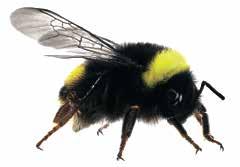
3 minute read
global briefs
Dig Business
Dinosaur Bone Ownership Resolved In 2018, the U.S. Ninth Circuit Court of Appeals ruled that fossils belonged to mineral rights owners, threatening to put a damper on scientific fossil hunting by paleontologists, but the Montana Supreme Court has now decided that fossils should not be deemed minerals, thereby restoring ownership of two dinosaurs buried together to the landowners, as had been customary in the past. A year after buying their property, Mary Anne and Lige Murray, along with a private fossil hunter, found an impressive array of specimens, including a complete Tyrannosaurus rex skeleton. Scientists like David Polly, an Indiana University paleontologist and past president of the Society of Vertebrate Paleontology, had warned that tying fossils to mineral rights would make it harder to get permission to excavate them and put the ownership of fossils already on display into doubt. They also feared that distinctive fossils would be purchased by private collectors, denying access to the public and researchers.
Advertisement
Pretty Kitty
Some Animals Garner Lion’s Share of Conservation Donations Sarah Papworth, a conservation biologist at the University of London, and artist Rory McCann designed a menagerie of imaginary beasts to find out which animals people were most willing to support. “Donations are really key to a lot of institutions,” says Diogo Veríssimo, a conservation biologist with the nonprofit San Diego Zoo Global. “Without them, many of the largest conservation organizations would struggle to survive.” It is common knowledge that people favor those they find adorable—tigers over turtles, for instance—but no one knows exactly which physical and nonphysical features motivate donors. From all the different body shapes, sizes, colors, eye positions and furriness, hundreds of past conservation donors ranked the imaginary species. Animals that were larger and more colorful were most likely to solicit donations, as reported in Conservation Letters. But it turns out that cuteness is not the only thing that matters, because the formula doesn’t account for the impact of popular culture. A study in Poland found that proboscis monkeys, once labeled the world’s ugliest primate, received a surge in donations through crowdfunding after starring in popular memes poking fun at their appearance. Maybe there really is no such thing as bad publicity.
Elbow Room
Nature Needs More Space All over the world, plants and animals are increasingly threatened by human activities and habitat encroachment. A 2019 studypublished in Science News estimates that 1 million ndrej Prosicky/Shutterstock.com species face extinction within decades. The natural world makes the planet livable by cleaning the air, filtering water, cycling carbon dioxide and pollinating crops. To impede biodiversity loss, governments are working to set aside more space for natural habitats. The UN Convention on Biodiversity ( Tinyurl.com/Post2020GlobalFramework), which is now under consideration, seeks to designate 30 percent of land and sea as protected by 2030 and 50 percent by 2050 in order to revive ecosystems and safeguard the diversity of species on Earth. Humans have altered more than three-quarters of Earth’s surface, and of the 14 terrestrial biomes, such as tropical rainforest, tundra or desert, eight retain less than 10 percent of undeveloped wilderness, according to a 2016 study in Current
Biology. Many species have already vanished.

Bug Bites
Bumblebees Chew Leaves to Hasten Pollen Production When trying to establish colonies in early spring, bees rely on flower pollen as a protein source for raising their young. Consuelo De Moraes, a chemical ecologist and entomologist at Eidgenössische Technische Hochschule Zurich, in Switzerland, reported in Science that at least three species of bumblebees use their mouth parts to snip little confetti bits out of plant foliage, and that the biting gets more widespread when there’s a pollen shortage. Experiments show that mustard and tomato plants nibbled by Bombus terrestris bees bloomed earlier than unbitten plants by days or weeks. In a caged-bee test, bumblebees trapped with non-blooming plants were more likely to poke holes in foliage after three days without pollen than a bee group buzzing among plentiful flowers. When researchers switched the bees’ situations, those trapped without blooms started nibbling leaves, too. Professor of Biology Dave Goulson, at the University of Sussex, in England, says, “I can imagine that hungry bees unable to find flowers might try biting leaves in desperation.”










